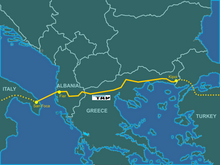Trans Adriatic Pipeline
| Trans Adriatic Pipeline | |
|---|---|
 |
|

Map of Trans Adriatic Pipeline
|
|
| Location | |
| Country |
Greece Albania Italy |
| General direction | East-West |
| From | Kipoi, Evros |
| Passes through | Fier |
| To | Melendugno |
| General information | |
| Type | Natural gas |
| Partners |
BP (20%) SOCAR (20%) Snam (20%) Fluxys (19%) Enagás (16%) Axpo (5%) |
| Operator | Trans Adriatic Pipeline AG |
| Construction started | 2015 |
| Expected | 2020 |
| Technical information | |
| Length | 878 km (546 mi) |
| Maximum discharge | 10–20 billion cubic metres per annum |
| Diameter | 48 in (1,219 mm) |
| Website | https://www.tap-ag.com/ |
Trans Adriatic Pipeline (TAP; Albanian: Gazsjellësi Trans-Adriatik, Azerbaijani: Trans Adriatik Boru Xətti Greek: Αδριατικός Αγωγός Φυσικού Αερίου, Italian: Gasdotto Trans-Adriatico) is a pipeline project to transport natural gas, starting from Greece via Albania and the Adriatic Sea to Italy and further to Western Europe.
The pipeline would be supplied by natural gas from the second stage of the Shah Deniz (Azerbaijan) gas field development in the Azerbaijani section of Caspian Sea through the South Caucasus Pipeline and the planned Trans Anatolian Pipeline (TANAP). Since it will enhance energy security and diversify gas supplies for several European markets, the TAP project is supported by the European institutions and seen as a "Project of Common Interest" and a part of the Southern Gas Corridor.
Trans Adriatic Pipeline project was announced in 2003 by Swiss energy company EGL Group (now named Axpo). The feasibility study was concluded in March 2006. Two options were investigated: a northern route through Bulgaria, the Republic of Macedonia and Albania, and a southern route through Greece and Albania, which finally was considered to be more feasible. In March 2007, the extended basic engineering for the pipeline was completed. Greece opposed for the route of the Trans Adriatic Pipeline passing through Albanian territory, as it would allow Albania to become transmission hub for gas in the Western Balkans.
...
Wikipedia
